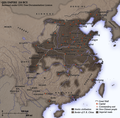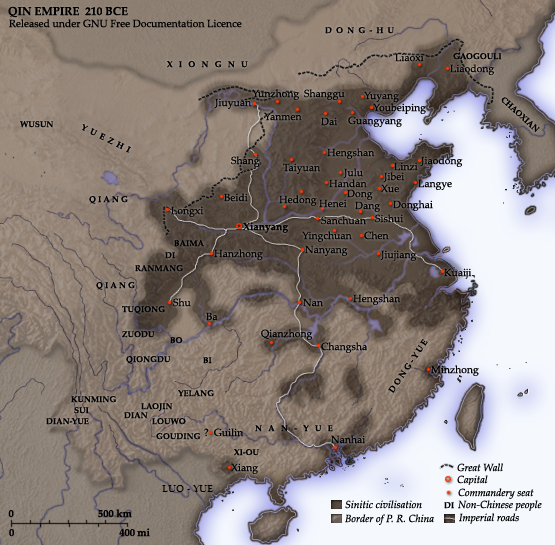Ficheru:Qin empire 210 BCE.png
Qin_empire_210_BCE.png (555 × 545 píxels, tamañu de ficheru: 567 kB, triba MIME: image/png)
Historial del ficheru
Calca nuna fecha/hora pa ver el ficheru como taba daquella.
| Data/Hora | Miniatura | Dimensiones | Usuariu | Comentariu | |
|---|---|---|---|---|---|
| actual | 14:37 10 avi 2014 |  | 555 × 545 (567 kB) | Nguyen1310 | Update to include ''Luo-Yue'' (Vi: ''Lạc Việt'') a member of the Baiyue (100 Yue) peoples, on the map in northern Vietnam. |
| 14:08 21 pay 2006 |  | 555 × 545 (540 kB) | Itsmine | == Commentary == As part of his unification of China in 221 BC, Qin Shi Huang divided his empire into thirty six commanderies, each subdivided into a number of counties. The significance of the administrative reforms was its in |
Usu del ficheru
Les páxines siguientes usen esti ficheru:
Usu global del ficheru
Estes otres wikis usen esti ficheru:
- Usu en af.wikipedia.org
- Usu en ar.wikipedia.org
- Usu en bg.wikipedia.org
- Usu en bo.wikipedia.org
- Usu en br.wikipedia.org
- Usu en bxr.wikipedia.org
- Usu en ca.wikipedia.org
- Usu en cdo.wikipedia.org
- Usu en cs.wikipedia.org
- Usu en cv.wikipedia.org
- Usu en cy.wikipedia.org
- Usu en da.wikipedia.org
- Usu en de.wikipedia.org
- Usu en en.wikipedia.org
- Usu en es.wikipedia.org
- Usu en eu.wikipedia.org
- Usu en fa.wikipedia.org
- Usu en fr.wikipedia.org
- Usu en ga.wikipedia.org
- Usu en gl.wikipedia.org
- Usu en hak.wikipedia.org
- Usu en he.wikipedia.org
- Usu en hi.wikipedia.org
- Usu en hr.wikipedia.org
- Usu en id.wikipedia.org
- Usu en incubator.wikimedia.org
- Usu en jv.wikipedia.org
- Usu en ka.wikipedia.org
- Usu en km.wikipedia.org
Ver más usos globales d'esti ficheru.




